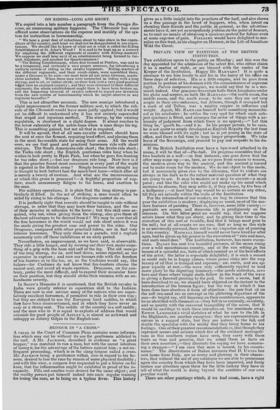ON RIDING—LONG AND SHORT.
WE copied into a late number a paragraph from the Foreign Re- view, on unmeaning military fopperies. The Chronicle has since offered some observations on the expense and inutility of the sys- tem for instruction in horsemanship.
. " We hear a great deal of reductions about to take place in the expen- diture of the country, and trust we shall not be disappointed in our expec. tations. We should like to know of what use is what is called the Riding "Establiiihment at St. John's Wood ? It is said to be kept up as a nursery for supplying the different regiments of cavalry with Riding-masters! We suppose we shall hear neat of an establishment being formed to fur- nish Adjutants, and another for Quartermasters ! " The Riding Establishment, when first formed at Pimlico, was said to be a temporary, and certainly a very proper measure, for introducing a uniform system of riding in the cavalry regiments. Riding-masters of the different regiments, and their rough-riders, were assembled there, under a German to be sure—we must have all our army German, musta- chios included. When these men were instructed in riding with a long stirrup, and to sit, or rather stride, on their fork (not a very good position tolget over an enclosed country), and they were returned to their different regiments, the whole establishment ought then to have been broken up, and the Inspecting General of cavalry ordered to report any deviation from the new system of horsemanship which he might observe in any regiment hereafter."
This is not altogether accurate. The new man'ege introduced a slight improvement on the former military seat, to which the ridi- cule of the Chronicle would have more justly applied ; but it would
yet be difficult to understand why it has not entirely superseded that stupid and injurious method. The stirrup, by the existing regulation, is shortened in a slight degree. It about reaches to the lower extremity of the ankle-bone when a- man drops his leg. This is-something gained, but not all that is required. It will be agreed, that of all men cavalry soldiers should have the seat at once the firmest, requiring least effort, and placing them in the most favourable state for using their arms. All the world -over, we see that good and practised horsemen ride with short stirrups. The South Americans ride short; the Arabs ride short ; the Turks ride short ; the English gentleman rides long when he wishes to look pretty in Hyde Park, but when he goes fox-hunting • he- too rides short ;—but our dragoons ride long. Now how is it that the practice found most convenient in every part of the world -is rejected in the British army ? Simply because the straight leg is thought to look bettert han the much bent knee—which after all is merely a beauty of custom. And what are the inconveniences at which this grace is procured P—A frightful proportion of rup- titre, much unnecessary fatigue to the horse, and exertion to the man.
For military operations, it is plain that the long stirrup is par- ticularly ill fitted. In the act of striking, a man would often be aided by rising in his stirrups. Our dragoons cannot do so.
It is perfectly right that recruits should be taught to ride without stirrups, in order that-they may learn their balance, and the use of their muscles in adhesion to the horse ; but this skill once ac- quired, why not, when "giving them the stirrup, also give them
the best advantages to be derived from it? We may be sure that all the fine horsemen in the world would not ride short unless it was the mode giving the greatest ease and power to the rider. Our Dragoons, compared with other practised riders, are in fact very inferior horsemen. They only shine on a parade, and a rupture commonly cuts off these exhibitions at an early period.
Nevertheless, an improvement, as we have said, is observable. They ride a little longer, and by turning out their toes, make some-
thing of a grip with the ham and calf of the leg. The old ma&ge
of the long stirrup, toe in, and heel down, seems rejected, as too expensive in rupture ; and now our hussars ride with the freedom of fox-hunters as to the toe, or, as the Cocknies would say, like tailors—for Cocknies do not know that fox-hunters choose the easiest seat, and avoid all waste exertion. Dragoons, on the con- trary, prefer the most difficult, and to expend their muscular force on their position, lest they should strike their enemies• with an un- handsome severity.
In SHIPP'S Memoirs it is mentioned, that the British cavalry in India were greatly inferior in equestrian skill to the Indians. There are now in our service many of the natives who are super- latively excellent horsemen, if permitted to ride in their own way ; but they are obliged to use the European hard saddles, to which they have been unaccustomed, and in which they have never an easy or a strong seat. The saddle of the country is a soft saddle ; and the man who in it is equal to exploits of address that would astonish the good people of ASTLEY'S, is almost as awkward and unhappy as Johnny Gilpin in the English seat.


















 Previous page
Previous page